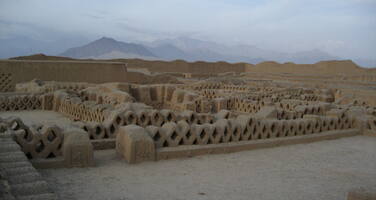Chan Chan Archaeological Zone
Factors affecting the property in 1999*
- Identity, social cohesion, changes in local population and community
- Land conversion
- Management systems/ management plan
- Other Threats:
Fragility of the abdobe structures
Factors* affecting the property identified in previous reports
- Fragility of its adobe structures;
- Occupation of land by farmers;
- Need of a management plan
International Assistance: requests for the property until 1999
Total amount approved : 118,700 USD
| 1998 | Master Plan for Chan Chan Archaeological Zone (Approved) | 8,700 USD |
| 1997 | Emergency assistance for the Archaeological Zone of ... (Approved) | 50,000 USD |
| 1997 | Technical advice for the preparation of an Integral ... (Approved) | 20,000 USD |
| 1994 | Regional and International Course on the Conservation ... (Approved) | 20,000 USD |
| 1987 | Consultancy and equipment for the safeguarding of Chan ... (Approved) | 20,000 USD |
Missions to the property until 1999**
Conservation issues presented to the World Heritage Committee in 1999
Summary of previous deliberations:
Twenty-first session of the Committee (paragraph number VII.29); Twenty-second session of the Bureau (paragraph number V.17); Twenty-second session of the Committee (paragraph number VII.19)
New information: The Master Plan for the site, reported upon at earlier Committee sessions, has not so far been concluded. The Second Pan-America Course on the Conservation and Management of Earthen Architectural and Archaeological Heritage (Government of Peru, ICCROM, CRATerre EAG, Getty Conservation Institute) will be held in Chan Chan in late 1999. The course will directly benefit the preservation and management planning for the site.
Summary of the interventions
Decisions adopted by the Committee in 1999
23 COM X.A.17
SOC: Chan Chan Archaeological Zone (Peru)
X.17 Chan Chan Archaeological Zone (Peru)
The Secretariat informed the Committee that it had received, some ten days before the Committee session, a copy of the very extensive and recently completed Master Plan for the site. This plan was prepared by an interdisciplinary group of experts with assistance from the World Heritage Fund. The Secretariat also reported that at the time of the meeting, the Second Pan-America Course on the Conservation and Management of Earthen Architectural and Archaeological Heritage (Government of Peru, ICCROM, CRATerre EAG, Getty Conservation Institute) was being held in Chan Chan and that this course would directly benefit the preservation and management planning for the site.
The Observer of Peru thanked the Committee for the support it had allocated to the preservation of the site and for the preparation of its Master Plan. She announced that the President of her country would sign, within the next days, the Decree that would formally adopt the Master Plan and that the Management Unit had started its work already to obtain funding for its implementation. She said that periodic reports on the progress would be submitted to the World Heritage Committee.
The Committee congratulated the Government of Peru for the accomplishment of the preparation of the Master Plan and encouraged the State Party to implement it. It requested ICOMOS and ICCROM to examine the Master Plan and to present their observations to the Bureau at its twenty-fourth session.
It requested the State Party to submit a progress report on the implementation of the Master Plan by 15 September 2000 for examination by the Committee at its twenty-fourth session.
The Committee decided to retain the property in the List of World Heritage in Danger.
The Committee may retain this site on the List of World Heritage in Danger. The Committee may request the State Party to submit the management plan for the Chan Chan Archaeological Zone as soon as it is finalised together with a report on the arrangements for its implementation.

Exports
* :
The threats indicated are listed in alphabetical order; their order does not constitute a classification according to the importance of their impact on the property.
Furthermore, they are presented irrespective of the type of threat faced by the property, i.e. with specific and proven imminent danger (“ascertained danger”) or with threats which could have deleterious effects on the property’s Outstanding Universal Value (“potential danger”).
** : All mission reports are not always available electronically.

